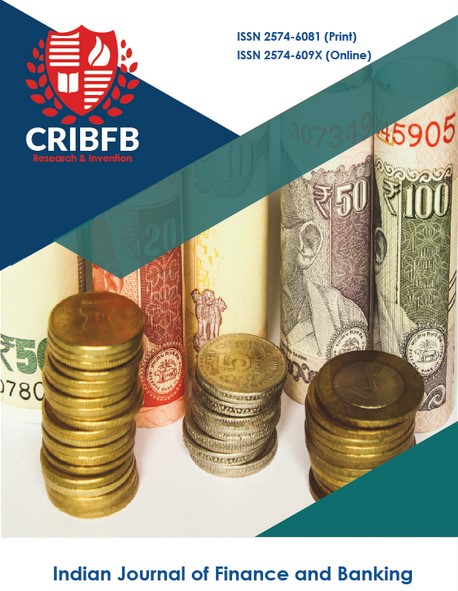Bank Performance versus Recession Indicators: A Linear Cointegration Approach
Main Article Content
Abstract
In this study, the researcher provides an empirical investigation of the nexus between banks’ performance and recession indicators. A sample size of 35 years was selected on annual data. A linear cointegration method was adopted after accounting for seasonality through logarithmic transformation. The results revealed that indicators of recession-exchange rate, inflation and interest rate maintain long run relationship with bank performance, and evidence of long run influence was established. Furthermore, we discover that within the purview of short run dynamic situation, inflation influences banks’ performance inversely, while exchange rate and interest rate increase with increase in banks’ performance. We therefore conclude that banks’ performance is driven by indicators of recession both in the short and in long run.
Downloads
Article Details
Section
How to Cite
References
Aubuchon, Craig P., and David C Wheelock. (2010). “The geographic distribution and characteristics of U.S. bank failures, 2007-2010: do bank failures still reflect local economic conditions?” Federal Reserve Bank of St. Louis Review, , (Sep): 395–415.
Beltratti, Andrea, and Ren M. Stulz. (2012). “The credit crisis around the globe: Why did some banks perform better?” Journal of Financial Economics, 105(1): 1–17
Berger, Allen N., and Christa H.S. Bouwman.(2013). “How does capital affect bank performance during financial crises?” Journal of Financial Economics,109(1): 146–176.
Cole, Rebel Allen, and Lawrence White. (2012). “D ́ej`a Vu All Over Again: The Causes of U.S. Commercial Bank Failures This Time Around.” Journal of Financial Services Research, 42(1): 5–29
De Young, Robert, and Gkhan Torna. (2013). “Nontraditional banking activities and bank failures during the financial crisis.” Journal of Financial Intermediation, 22(3): 397–421
Fahlenbrach, Rdiger, and Ren M. Stulz. (2011). “Bank CEO incentives and the credit crisis.” Journal of Financial Economics, 99(1): 11–26.
Fahlenbrach, Rdiger, Robert Prilmeier, and Ren M. Stulz. (2012). “This Time Is the Same: Using Bank Performance in 1998 to Explain Bank Performance during the Recent Financial Crisis.” Journal of Finance, 67(6): 2139–2185.
Golden, Sam and Harry (1993): The Ten Commandments of Commercial Credit. The Cs of good and bad oans. Journal of Commerial Bank Leading
Laeven, Luc, and Ross Levine. (2009). “Bank governance, regulation and risk taking.” Journal of Financial Economics, 93(2): 259–275
Peek, Joe, and Eric Rosengren. (1997). “How well capitalized are well-capitalized banks?” New England Economic Review, , (Sep): 41–50
Ratnovski, Lev, and Rocco Huang. (2009). “Why are Canadian Banks More Resilient?” IMF Working Paper, 1–19.
Wheelock, David C, and Paul W. Wilson. (2000). “Why do Banks Disappear? The Determinants of U.S. Bank Failures and Acquisitions.” The Review of Economics and Statistics, 82(1): 127–138.
Waweru, N.M. and Kalani, V.M. (2009). Commercial Banking Crises in Kenya: Causes and Remedies. African Journal of Accounting, Economic, Finance and Banking Research, (N), 12-33
Mc Nulty, J., Akhigbe, A. & Verbrugge, J.(2001). Small Bank loan quality in a Deregulated Environment: The information advantage hypothesis.Journal of Economics and Business, 53, 325-39.
Samuel, K.S.(2011): Lending practices and causes of loan defaults. Leading practices and causes of loan default among some selected banks in Ghana.




